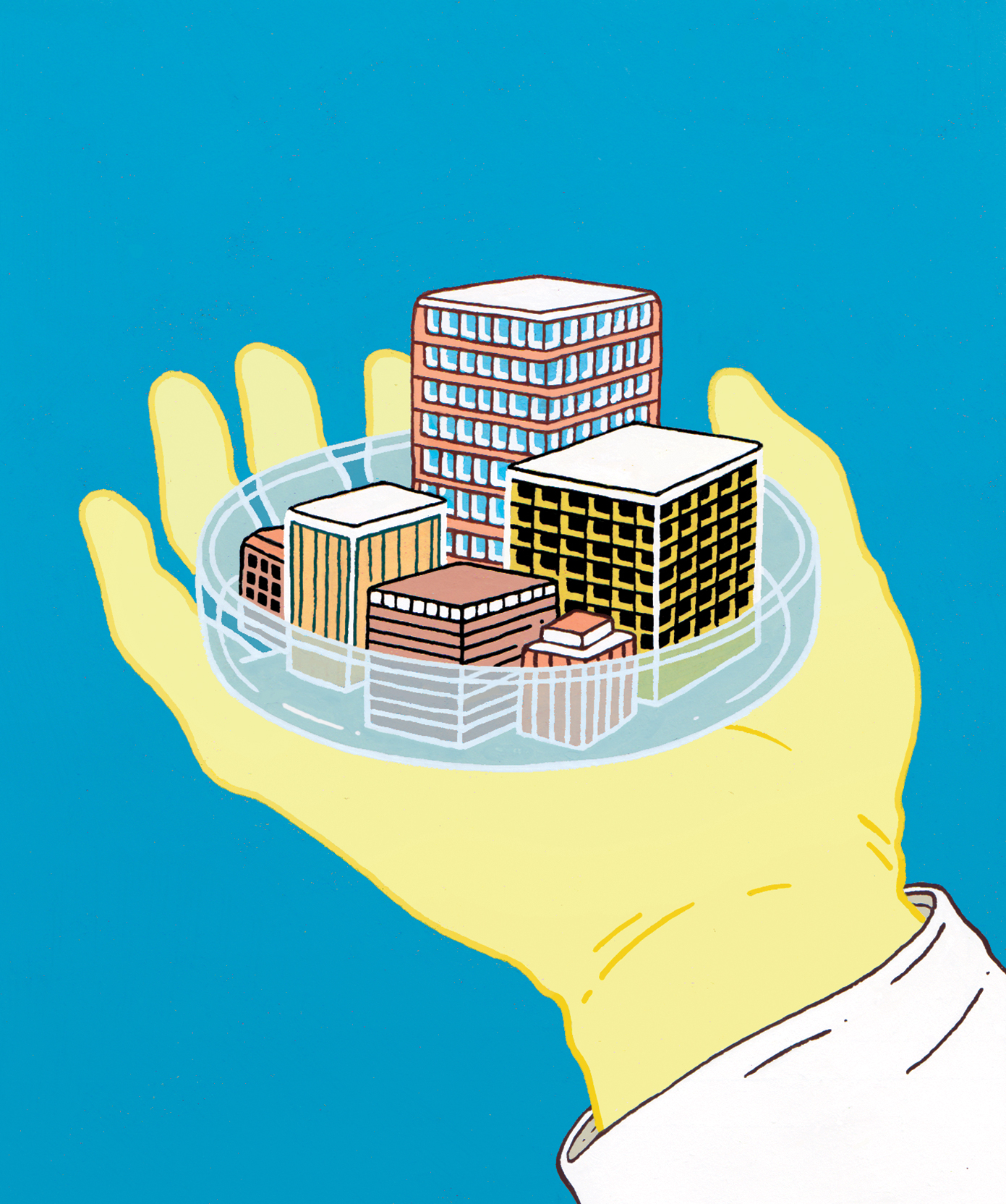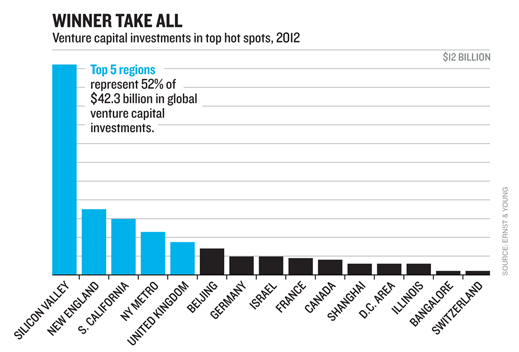In Innovation Quest, Regions Seek Critical Mass

There is a spot just off the MIT campus in Cambridge, Massachusetts, that is home to what may be the world’s densest concentration of startup companies. There, near the edge of Kendall Square, the founders of more than 450 startups crowd into nine floors. Some occupy common rooms where the rule is “Grab any seat you can.”
On a heat map of innovation, the place is glowing bright red. Sharing the same elevator banks are venture capital firms that collectively manage funds totaling $8.7 billion. Fifteen years ago, the local tech scene was anemic and there were few investors. Now Kendall is a beacon that’s drawing more and more technology companies. Amazon has moved a mobile development team to the area, Google has expanded quickly into new buildings, and drug companies are piling in, too.
Kendall has become what economists call a cluster, a concentration of interconnected companies that both compete and collaborate. There’s economic value in that, as the price of office space attests: rents have spiked to $70 per square foot from half that a decade ago, similar to what you’d pay in midtown Manhattan. “Rents don’t lie,” says Tim Rowe, head of the Cambridge Innovation Center, the shared office space where most of the startups are located.
There’s value to the region as well. Cities used to try to win jobs by “smokestack chasing,” or luring big industries. But large existing firms tend to shed jobs, research has found. At least in the United States, net job growth comes from startup companies, especially the kind that explode from a few employees to several thousand. In technology, those winners have a way of producing more winners. The process reaches critical mass in the web of intertwined companies, resources, advantages, ideas, talent, opportunity, and serendipity that defines a technology cluster.
It’s clear that what’s essential is proximity to human talent and new ideas. Jean-François Formela, a venture capitalist at Atlas Venture who invests in early-stage biotechnology startups, says he visits Boston-area academic labs several times a week, trying to find the next invention that he can license and turn into a company. And because there are so many PhDs and MDs in the area, he can start a company and build a team remarkably fast. “People don’t even have to change buildings,” he says. “They just switch floors.”

The big questions in this month’s MIT Technology Review Business Report are why technology clusters arise and what the ingredients are to create one (see “Silicon Valley Can’t Be Copied”). Unhappily for regions that have spent billions attempting to become the next Silicon Valley, the answers to these questions are still in debate. “Clusters exist—it’s empirically proven,” Yasuyuki Motoyama, a senior scholar at the Kauffman Foundation, told me. “But that doesn’t mean governments can create one.”
What’s certain is that they are trying. The largest such effort we know of is the Skolkovo complex outside Moscow, where $2.5 billion is being invested in a university, a technology park, and a foundation. Another, in Waterloo, Ontario, aims at gaining a lead in a particular advanced technology, quantum computing. The price tag there: more than $750 million.
The problem for governments is that they often try to define where and when innovation will occur. Some attempt to pick and fund winning companies. Such efforts have rarely worked well, says Josh Lerner, a professor at Harvard Business School. Governments can play a role, he says, but they should limit themselves mostly to “setting the table”: create laws that don’t penalize failed entrepreneurs, reduce taxes, and spend heavily on R&D. Then get out of the way.
Still, there’s no recipe that guarantees success. One reason is that some hard-to-copy ingredient—a fluke of history or culture—often helps explain the vibrancy of a technology hub. Take Israel, where per capita venture capital investment is the highest of any country. Most young people go through compulsory military service, where they are exposed to advanced technology and learn teamwork. Google chairman Eric Schmidt, after visiting last summer, was impressed by Israel’s unique “live for today” attitude toward taking entrepreneurial risks (see “Israel’s Military-Entrepreneurial Complex Owns Big Data”).
Even so, a wider group of cities and regions now aspire to become technology hubs. One reason is that the Internet has spread both the ideology of startup culture (you, too, can be Mark Zuckerberg) and the means of participating through apps and Web software. Now every place from Chile to Iceland to Adelaide, Australia, seems to have created a startup program in an effort to jump-start its own technology scene without expensive laboratories or even a top university.
One proponent of this idea is Brad Feld, a partner at Foundry Group and a creator of the technology company accelerator TechStars, who developed what he calls the “Boulder Thesis” based on his experiences in Colorado (see “It’s Up to You, Entrepreneurs”). It is a four-point plan for how entrepreneurs—not governments or universities—can organize and create what he terms “entrepreneurial communities” in any city. Feld says the startup movement is now an “enormous global community with tens of thousands, hundreds of thousands, of people around the world.”
But can entrepreneurs succeed in creating clusters where governments have had so much difficulty? “The conflict now is between two logics on how to create an ecosystem,” says Fiona Murray, a professor at MIT’s Sloan School, who consults as a kind of therapist to clusters, including London’s TechCity. One is “a government logic that says it’s too important to leave to entrepreneurs, and that you that need specialized inputs, like a technology park.” The other is “purely focused on people and their networks.”
Murray believes the answer lies somewhere in the middle. Governments are good at organizing but poor at leading. One popular approach these days is to pair entrepreneurship programs with urban revitalization projects. In this issue, we visit Zappos CEO Tony Hsieh, who is trying to morph Las Vegas’s depressed downtown into a scene for startups. He’s trying to make it a cool place to be, and because Las Vegas is so spread out, he’s reserved 100 Tesla electric sedans to ferry entrepreneurs around town. That way, he says, he’ll increase the odds of serendipity (see “Zappos CEO Bets $350 Million on a Las Vegas Startup Scene”).
The risk of all these plans is that economists still don’t agree on exactly what levers must be pulled to create a technology cluster. But there is one finding they agree on. Centers of innovation do move, sometimes rapidly, and they tend to go where the latest mousetrap was invented. Boston gave up its lead in computing to Silicon Valley in the 1980s, after the personal computer was developed. But who knows? One of those 450 startups in Kendall might just hit upon something big. That’s a reason that any place can still hope—with a few decades of effort, and plenty of luck—to become a Silicon Valley too.
Keep Reading
Most Popular
Large language models can do jaw-dropping things. But nobody knows exactly why.
And that's a problem. Figuring it out is one of the biggest scientific puzzles of our time and a crucial step towards controlling more powerful future models.
The problem with plug-in hybrids? Their drivers.
Plug-in hybrids are often sold as a transition to EVs, but new data from Europe shows we’re still underestimating the emissions they produce.
How scientists traced a mysterious covid case back to six toilets
When wastewater surveillance turns into a hunt for a single infected individual, the ethics get tricky.
Google DeepMind’s new generative model makes Super Mario–like games from scratch
Genie learns how to control games by watching hours and hours of video. It could help train next-gen robots too.
Stay connected
Get the latest updates from
MIT Technology Review
Discover special offers, top stories, upcoming events, and more.